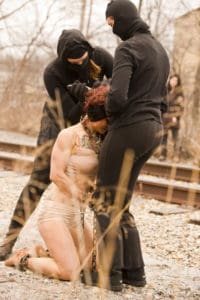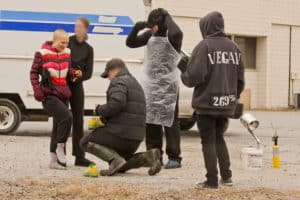This live human branding demonstration shines a light on our treatment of animals. They fear as I fear, bleed as I bleed, and suffer as I suffer; the crucial difference between them and me is they had no choice.
The Branding was a live demonstration, executed on January 27th, 2013 in Iowa City, IA.
Event Photos
Expand each accordion to view the event photos. Click any image to enlarge and move through the image gallery.
Artist Statement
The following is my artist statement, first published in Blue Planet Green Living.
The moment the brand hits my skin, I can’t help but think of them. Him cramped in a metal cell, absolutely terrified, the barrel of a gun to his temple. Her crying out as her child is ripped away from her moments after his birth, the third child of hers taken from her this way. And here I lie, face down on the cold earth, my head freshly shorn of its mid-back-length hair, my side literally on fire as the brand melts through layers of my flesh.
I’ve gotten off easy.
Unlike me, they weren’t so lucky. Unlike me, they lost their lives.
In the United States alone, 8.3 billion animals were killed for food in 2012, according to the USDA’s National Agriculture’s Statistics Service. Given this data does not include fish, marine animals, crustaceans, rabbits, other farmed animals, or animals killed for their fur or other “byproducts,” this figure is a gross underestimation.
Isaac Bashevis Singer, Jewish Author and Nobel Laureate wrote, “in relation to them [animals], all people are Nazis; for the animals it is an eternal Treblinka.” Theodor Adorno, German Jewish philosopher, sociologist, and musicologist, stated, “Auschwitz begins whenever someone looks at a slaughterhouse and thinks: they are only animals.”
This is a global holocaust beyond the scale of recorded history: In the split second the brand is touching my skin, 263.2 animals in the US and 4,756.5 animals worldwide lose their lives.
It is January 27th, 2013, the day designated by the United Nations as the International Day of Commemoration in Memory of the Victims of the Holocaust. On this day in Iowa City, Iowa, at approximately 8 a.m., I am branded with a steel cattle iron in front of a rusted shed by a desolate railroad track.
On October 2, 2012, three vegan activists in Israel were branded with the number 269 in a public square in Tel Aviv. Having visited an Israeli factory farm and encountered a calf tagged with the industry-given number of 269, these activists had themselves branded in the traditional fire-heated method long employed by the farming industry. The manifesto of their organization 269life, states, “The branding of the calf’s number, chosen by the industry to be ‘269,’ is for us an act of solidarity and immortalization. We hope to be able to raise awareness and empathy towards those whose cries of terror and pain are only heard by steel bars and the blood stained walls of the slaughterhouses.”
I contacted Sasha Boojor, one of 269life’s founders, and discussed the possibility of staging an event in Iowa City. As a resident of Iowa, I am painfully aware that I live in the heart of industrial farming and agriculture. Out of the over 10,000,000 pigs that were slaughtered in November 2012, 2,700,000 of them were killed in Iowa, a total well over two times that of the next highest state.
The center of the United States is the historical source of factory farming as we know it. Born in Chicago in the days of Sinclair’s The Jungle, and “perfected” to a horrific efficiency decades later in Denison, Iowa by Iowa Beef Packers (IBP), assembly-line slaughter is a product of the American Midwest. Henry Ford himself found the inspiration for his automobile factory in the efficiency of a Chicago beef plant.
As with every industry, the faster the line moves, the more product produced, the higher the profit. Only here, “product” is the flesh of living beings, who are “produced” by violent slaughter for profit. The Animal Welfare Act, passed in 1966 and enforced by the USDA, “regulates the care and treatment of warm-blooded animals, except those (such as farm animals) that are used for food, fiber, or other agricultural purposes” [emphasis added]. Coldblooded animals, such as snakes and alligators, are also exempt from the act’s protection.
These are the arbitrary distinctions we make for who deserves safety, for who deserves to live. As a species, we have long drawn hard distinctions between races, genders, classes, and other perceived boundaries within humanity. With time, this hierarchical structure has proved to be arbitrary, abusive, and unjust. How, then, are the distinctions between the human animal and other feeling, sentient animals any more valid, any less arbitrary? Are not they simply the unjust hierarchy of our present day?
The apparent gulf we place between the slaughterhouse and the Holocaust can also be seen as a forced distinction. In his book Eternal Treblinka, Holocaust scholar Dr. Charles Patterson draws connections between our treatment of animals and the Holocaust. He speaks with Holocaust survivors, who tell how their experience of suffering drove them to animal activism.
In the four months of planning for my own branding, I was faced with many challenges. The event was originally supposed to take place in front of the Old Capitol building in downtown Iowa City, now owned by the University of Iowa. Once contacted by the press, the University pulled the permit I had secured in the previous months, stating my event violated their policy against “bodily harm.”
I also had multiple participants back out of the project altogether. The original individual on board to film the event emailed me one morning saying he was uncomfortable being a part of something during which I would be injured and suffer, and he could not participate any further. There were also legal and real medical concerns that frightened people. In Iowa winter weather, there is always risk of hypothermia and frostbite. And, in all reality, I would be receiving a first-degree burn.
My response to this apprehension and disapproval was, “That is exactly what this event is about!” All the fear and concern for me, for ourselves, for the legal aspects and the possible outrage the event would cause, it was all for an act that is done to millions of animals every day.
Why is it so objectionable against the human animal but not them? Their capacity to emote is no less than ours. Does a steer awaiting slaughter not smell the blood and fear of those before him? Does a mother cow not cry out when her child is taken from her moments after birth? Does a baby chick not feel pain as her beak is cut off without anesthesia? Or a young pig as he is castrated while fully conscious? We cannot hear their cries and see their eyes fill with terror and say they are separate from us. Fear is Fear. Blood is Blood. Suffering is Suffering.
I think we should all feel how those who declined to participate and the University officials who pulled my permit felt about this event. Only we should extend this feeling to all the beings who are subjected to this and more every day. What I went through is not even close to a fraction of the horrors the animals experience. I don’t see a distinction between them and myself, save for one crucial difference: I have a choice. I get to go home.
I get to live.
Performance Reflection
The following is my performance reflection, first published by Negotiation is Over.
It has been two months since I was bound with chains, dragged across jagged rocks in the freezing rain, shorn of my mid-back-length hair, and branded with a cattle iron heated to over 500°F. I am now bald, scarred and permanently marked.
But I’m alive. Others are not so lucky.
Unlike me, billions worldwide do not get to return to their homes, nurse their wounds, and move on. Unlike me, they have no choice in the matter. Unlike me, they lose their lives.
In my case, the caging, binding, shaving, and branding were voluntary and consensual aspects of a demonstration with which I hope to bring attention to the suffering and death of those who do not give consent and have no voice.
In this country alone, 8.3 billion animals were killed for food in 2012, according to the USDA’s National Agriculture’s Statistics Service. This estimate is a gross underestimation, given this data does not include fish, marine animals, crustaceans, rabbits, other farmed animals, or animals killed for their fur or other “byproducts.”
Here we may morally draw a distinction: they are animals, we are humans. We may place our welfare above theirs. Perceive their suffering to be comparatively lacking in depth. We create barriers, categories and divisions: them and us.
We humans have long drawn arbitrary lines between races, classes, genders, and other perceived boundaries within our own species. But is our self-imposed separation from animals any less arbitrary? Theodor Adorno, German Jewish philosopher, sociologist, and musicologist warns us that “Auschwitz begins whenever someone looks at a slaughterhouse and thinks: they are only animals.”
It is with this caution in mind that, on January 27th, 2013, the day designated by the United Nations as the International Day of Commemoration in Memory of the Victims of the Holocaust, I orchestrated my own branding in front of a rusted steel shed by a desolate railroad track in Iowa City, IA.
The exact number I was branded with, 269, is the industry-give number of a calf born in a factory farm in Israel. On October 2, 2012, three vegan activists in Israel were branded with the number 269 in a public square in Tel Aviv. They took on his number to give a face to the faceless and a voice to the voiceless. Three months later, on the other side of the world, in the middle of America, I used the very same branding iron on my flesh.
Living in Iowa, I’m painfully aware that I’m in the center of American factory farming and industrial agriculture. The “assembly line” slaughter practiced worldwide was born in the American Midwest within the beef plants of Chicago.
Exposed for its horrific lack of sanitation and abusive practices by Sinclair’s “The Jungle,” the meat packing industry temporarily became a safer, cleaner industry. However, today, the “don’t break the chain” mentality captured in Eric Schlosser’s “Fast Food Nation” is back in full swing, having been resurrected and “perfected” in Denison, IA, by Iowa Beef Packers (IBP), now Tyson Foods. As with every industry, the faster the chain moves, the more product produced, the higher the profit. Only in this case, the “product” is a living being who is “produced” by being slaughtered.
In the months leading up to my branding event, I experienced a great deal of resistance and hit may roadblocks. Once the press questioned the University of Iowa, where I’d originally planned to hold the event, about the branding, my permission for the site was withdrawn. I had multiple individuals back out of participating in the event due to legal and medical concerns.
Since the event, I’ve received a range of feedback, including outrage and disgust. My reaction is the same now as it was to those who declined to participate out of concern for legality and medical safety: If we are so outraged, concerned, and offended by this voluntary act of mine, how can we be complicit participants in the enslavement, torture and murder of other sentient beings? What I went through was nothing by comparison.
Others fear as I fear, bleed as I bleed, and suffer as I suffer; the crucial difference between them and me is they had no choice. While I experienced momentary discomfort, they were systematically abused. While I was performing for a cause, they were anything but pretending. While I am home nursing my wounds, they are bleeding out and dying a conscious, fear-filled death.
If we find comfort in distancing ourselves from their plight with our arbitrary divisions, we best remember what Holocaust scholar Dr. Charles Patterson wrote in his book Eternal Treblinka: Our Treatment of Animals and the Holocaust:
“Throughout the history of our ascent to dominance as the master species, our victimization of animals has served as the model and foundation for our victimization of each other. It is significant that the Nazis treated their victims like animals before they murdered them. The study of human history reveals a pattern: first, humans exploit and slaughter animals; then, they treat other people like animals and do the same to them.”
A child of Holocaust survivors, Anne Muller empathizes with those exploited, stating,
“when you grow up learning about how your family was killed by a government and by people who thought they were worthless, or worse, and who had absolute power over them and exercised it with brutal force, taking everything, even their lives, you can’t help but feel deeply for those who are in that predicament. Animals are weak, they have no voice, they can’t help each other or themselves. We were like that too.”
Pre-Performance Editorial Statement
The following is my editorial statement in response to the pre-performance article “Iowa City Woman Plans to Brand Herself: UI Grad Drawing Attention to ‘horrific’ Ways Animals Are Treated.” Iowa City Press Citizen, January 18, 2013. My editorial was originally published in the Iowa City Press Citizen.
What is more extreme? Using 2,500 gallons of water, 55 square feet of rainforest, 17 pounds of grain, and 27 times the daily carbon emissions of the average car, to produce one pound of beef? Or plucking ripe produce from a fruit-bearing plant?
Or let us compare the simple, swift movement of a sharpened blade. On the one hand, this blade slits the carotid artery of someone’s child while he hangs helpless and conscious, choking on his own blood as his brother, a second later, meets the same fate. On the other hand, this blade cuts through a tomato, the red juice not as dark as the child’s blood and no choked death-cry to be heard.
Same action. Same tool. Which is more extreme?
In the planning and execution of my public branding performance piece, I’ve been told numerous times that my action is “extreme.” My art in general has been dismissed more than once as merely “shocking.”
I find the realities I’m bringing to light to be shocking and extreme; however, my actions are rather banal in comparison. Let’s look at Sunday’s performance piece, for example.
I will willingly, consciously, and with my full consent be branded with a cattle iron. I will be executing a carefully-planned, well researched action during which I will experience pain, granted most likely extreme. I will receive medical aftercare for my burn. I will return home safely.
This voluntary action of mine may seem shocking and extreme to some; however, the reality I’m hoping to shed light on is most certainly both. If we are so outraged, so upset over my voluntary choice to have myself branded, why are we OK with the involuntary enslavement, torture and murder of other animals? How is my act of momentary discomfort more offensive than the daily murder of millions?
In the U.S. alone, 8.3 billion animals were killed for food in 2012, according to the USDA’s National Agriculture’s Statistics Service. These figures are a gross understatement given this data includes only federally inspected plants and does not include fish, marine animals, crustaceans, rabbits, other farmed animals or animals killed for their fur or other “byproducts.” In the month of November 2012, 12.89 million cattle, 252,3000 veal calves, 10.11 million pigs, 181,800 sheep and an average of 679,500 chickens and turkeys were killed in the U.S.
We Americans often cringe at cultures that slaughter and eat dogs, feeling disgust at their callousness while we savor our pork loins. We don’t stop to think of the hypocrisy in our actions.
Pigs, far more intelligent than any breed of dog, are capable of abstract representation and are ranked fourth in animal intelligence, having been shown to remember commands learned over three years ago, according to Stanley Curtis, formerly of Penn State University.
Intelligence aside, there is the undeniable fact that pigs think, feel, emote and, of course, suffer.
Living in Iowa, we are in the center of America’s pork industry, industrial agriculture and factory farming. Out of the 10.1 million pigs that were slaughtered in November 2012, 2.7 million of them were killed in Iowa, a total well over two times that of the next highest state.
Its facts like these that leave me rather befuddled when someone observing my lettuce-filled-meal calls me extreme as they bite into their meat product, so severely processed that its flavor has been scientifically designed and distilled by a flavorist.
Consider this: in the split second the brand will be touching my skin, 263 animals in the U.S. and 4,757 animals worldwide will be killed, according to the USDA and United Nations.
Once again, I ask what is more extreme?
— Emily Moran Barwick



























































